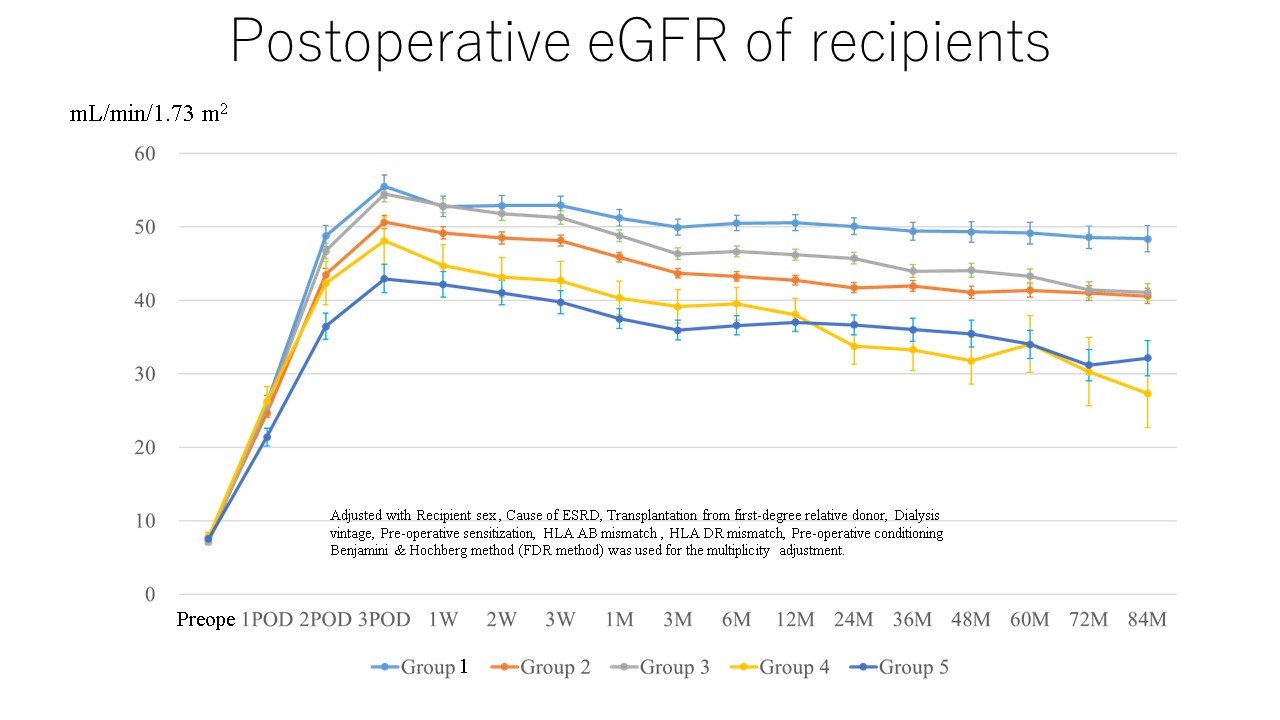The Impact of Donor Age and Donor-Recipient Age Difference on Living Donor Kidney Transplantation
1Nagoya Daini Red Cross Hospital, Myokencho Showaku, Japan, 2Nagoya Daini Red Cross Hospital, Nagoya, Japan
Meeting: 2021 American Transplant Congress
Abstract number: 963
Keywords: Age factors, Graft failure, Kidney transplantation, Living donor
Topic: Clinical Science » Kidney » Kidney Living Donor: Other
Session Information
Session Name: Kidney Living Donor: Other
Session Type: Poster Abstract
Session Date & Time: None. Available on demand.
Location: Virtual
*Purpose: The impact of donor age and donor-recipient age difference on living donor kidney transplantation have not been investigated simultaneously.
*Methods: A total 805 adult living donor kidney transplantation between January 2008 and December 2018 including donor age > 30 years old and donor-recipient age difference -10 – +10 years or +20 – +40 years was investigated. Recipients were stratified into 5 groups according to the donor age and donor-recipient age difference: Group 1 (120 recipients), donor age 30 – 49 years old and donor-recipient age difference-10 – +10 years; Group 2 (338 recipients), donor age 50 – 69 years old and donor-recipient age difference-10 – +10 years; Group 3 (240 recipients), donor age 50 – 69 years old and donor-recipient age difference +20 – +40 years; Group 4 (28 recipients), donor age 70 – 89 years old and donor-recipient age difference -10 – +10 years; Group 5 (79 recipients), donor age 70 – 89 years old and donor-recipient age difference +20 – +40 years. Recipient postoperative eGFR was compared with linear mixed model analysis. Benjamini & Hochberg method was used for multiple comparisons. Risk of graft loss was analyzed with Cox regression hazard model.
*Results: In the recipient and donor characteristics, significant differences were identified in donor sex, recipient sex, cause of end stage renal disease, recipient body mass index, relationship between donor and recipient, dialysis vintage, preoperative sensitization, HLA AB mismatch, HLA DR mismatch, preoperative conditioning including retuximab and plasmapharesis, and calcineurin inhibitor at transplant. Postoperative eGFR of recipients were adjusted for these factors. The postoperative eGFR showed difference among groups.
eGFR of Group 4 and 5 were the lowest and eGFR of Group 1 was the highest among groups. Univariate analysis of Cox regression hazard model showed Group 4, recipient sex, preoperative sensitization including transplantation, pregnancy, and transfusion were the significant risk for the graft loss (P = 0.001, P = 0.016, P = 0.020, respectively). Multivariate analysis showed Group 4 and recipient sex were the significant risk for graft loss (P < 0.001, hazard ratio 19.07, 95% confidence interval 4.877 - 74.558, P = 0.045, hazard ratio 2.74 95% confidence interval 1.022 - 7.346).
*Conclusions: Postoperative eGFR of recipients correlated with donor age. Donor age 70 – 89 years old and donor-recipient age difference -10 – +10 years was the significant risk for the graft loss.
To cite this abstract in AMA style:
Hiramitsu T, Tomosugi T, Futamura K, Okada M, Goto N, Ichimori T, Narumi S, Watarai Y. The Impact of Donor Age and Donor-Recipient Age Difference on Living Donor Kidney Transplantation [abstract]. Am J Transplant. 2021; 21 (suppl 3). https://atcmeetingabstracts.com/abstract/the-impact-of-donor-age-and-donor-recipient-age-difference-on-living-donor-kidney-transplantation/. Accessed December 10, 2025.« Back to 2021 American Transplant Congress

